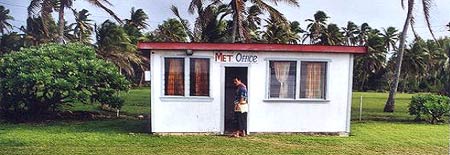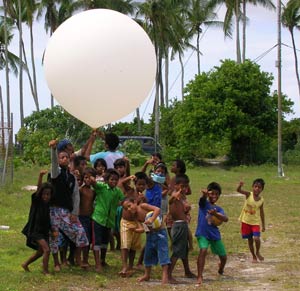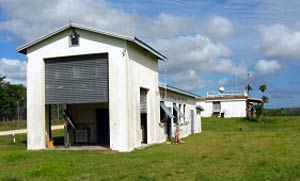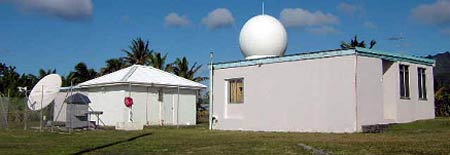Tiempo Climate Cyberlibrary
Enhancing Meteorological Services in the Pacific
- Tiempo archive
- Complete issues
- Selected articles
- Cartoons
- Climate treaty
- Latest news
- Secretariat
- National reports
- IPCC
About the Cyberlibrary
The Tiempo Climate Cyberlibrary was developed by Mick Kelly and Sarah Granich on behalf of the Stockholm Environment Institute and the International Institute for Environment and Development, with sponsorship from the Swedish International Development Cooperation Agency.
While every effort is made to ensure that information on this site, and on other sites that are referenced here, is accurate, no liability for loss or damage resulting from use of this information can be accepted.
 |
Effective progress is being made in developing the self-sufficiency of meteorological services in Pacific Islands through assistance from New Zealand and other international development partners. Penehuro Lefale reports. |
| The author is manager of the International Cooperation and Development Unit in the National Weather Service department of the Meteorological Service of New Zealand. He has worked extensively on the research and development of meteorological and related climate change issues in the Pacific region. | |
For over fifty years, New Zealand has played a leading role in the provision and the development of meteorological services in the Southwest Pacific. Since 1984, support has been realigned towards development, which means that New Zealand now has a reduced or only back-up involvement in the actual provision of meteorological services. The focus has moved from directly managing meteorological services to providing advice and assistance on a project basis with funding from various sources, including bilateral and multilateral agreements as well as from the funds of the Meteorological Service of New Zealand (MetService).
Some of the projects are in the form of long-term consultancies and may last a few years. Others are one-off specific projects such as the United Kingdom Foreign and Commonwealth Office-, United Kingdom Met Office- and New Zealand MetService-funded project, REStoring aging weather, Climate and Upper air Equipment in PACific Islands (RESCUE-PAC).
 |
| Meteorological Office, Ha'apai, Tonga. Ha'apai is one of several offices that has benefited from the RESCUE-PAC project |
New Zealand's present assistance to meteorological services in the South Pacific is predominantly bilateral in nature. The necessary funding to provide this assistance continues to be secured through both a supply contract with the New Zealand Government for "public good" services and through other New Zealand agencies on a project basis. In addition to the support provided with New Zealand funding, the MetService also provides substantial technical resources for routine operational support and project implementation in the South Pacific region, which is funded from agencies outside of New Zealand.
In 2006, for example, New Zealand continued to advise and assist the Pacific countries of the Cook Islands, Kiribati, Niue, Samoa, Tokelau, Tonga and Tuvalu. All these countries received remote on-going advice and assistance for computer and other operational problems, as well as an annual re-supply of meteorological forms.
 |
Tawara Upper Air programme operations, Kiribati Meteorological Service, Betio, Tawara, Kiribati |
The MetService continues to monitor surface and upper air observations reporting performance for the assisted countries, together with providing an email gateway to the Global Telecommunications System, which ensures they can participate in the international exchange of data. Country visits have been made to the Cook Islands, Niue, Kiribati, Tuvalu, Samoa and Tokelau. New Zealand is also responsible for providing temporary backup, which is usually up to about a week, for weather warnings and very limited marine and aviation services under the terms of the World Meteorological Organization Tropical Cyclone Plan for the region. The Tropical Cyclone Plan ensures effective coordination and cooperation in the provision of meteorological information, forecasts and warnings of all tropical cyclones affecting the area.
New Zealand continues to manage and technically support the upper air programmes at Tarawa (Kiribati), Funafuti (Tuvalu), Penrhyn (Cook Islands), Bauerfield (Vanuatu), Port Moresby (Papua New Guinea) and Honiara (Solomon Islands), as part of its contribution to the Global Upper Air Network (GUAN) and the Pacific Island Global Climate Observing System (PI-GCOS). This also includes some financial support, although consumables and operating costs for these programmes are primarily funded by the United Kingdom Met Office (UKMO) and the United States National Oceanic and Atmospheric Administration's Global Climate Observing System (US NOAA GCOS) programme.
 |
Restored Bauerfield GUAN Station, Vanuatu. This station had been silent for over ten years. The restoration was funded by the US NOAA GCOS, UKMO and MetService |
Another role New Zealand has taken in assisting in the enhancement of meteorological services in this region has been as co-initiator of the RANET project in the Pacific region. The RANET - Radio and Internet for the Communication of Hydro-Meteorological and Climate Related Information - project aims to improve access to information and support of rural communities. The RANET project work was undertaken in collaboration with Australia, the United States and the United Kingdom. This included installation of high frequency/very high frequency (HF/VHF) radios for local communities in Vanuatu, Tuvalu and Niue.
New Zealand has also funded the restoration of the fire-damaged Wind Finder Radar at Rarotonga Airport, Cook Islands. In June 2005, a fire in the radar equipment room extensively damaged the wind finding radar facility at Raratonga. The New Zealand MetService was contracted by the Cook Islands Public Service Commission, the Cook Islands Meteorological Service, the New Zealand International Aid and Development Agency (NZAID) and the UKMO to restore the fire-damaged facility. In response, the New Zealand MetService carried out a technical evaluation in July 2005. The aim was to ascertain, as far as practicable, the extent of the damage both visible and hidden, and to scope and cost the repair of the facility. The technical evaluation formed the basis for the Rarotonga Wind Finding radar restoration project (RaWFind).
 |
| Wind Finder Radar, Rarotonga, Cook Islands. Restoration of the fire-damaged radar was completed in April 2007 |
Upper air measurements are now back to normal at Rarotonga after the restoration of the radar facility. However, installation and replacement of vital equipment needs to be carried out immediately so as to ensure the longevity of the wind finding radar facility. Much of the equipment in need of replacement, including the dehumidifier that is used to keep the antenna dome dry, is at least 20 years old.
As part of its commitment to enhancing the meteorological services in the Southwest Pacific, New Zealand continues to fund the preparation and publication of the monthly Island Climate Update, which is managed and implemented by the National Institute of Water and Atmospheric Research (NIWA). The Island Climate Update is a multinational monthly climate bulletin. Its primary goal is to assist Small Island Developing States of the South Pacific make informed planning and management decisions relating to climate-sensitive sectors like agriculture, water, tourism, fisheries and energy through the provision of timely and accurate seasonal climate forecasts. New Zealand also actively contributes to the PI-GCOS and other communications solutions such as HF radio and satellite email and the Emergency Managers Weather Information Network.
The ultimate goal of New Zealand's support is to assist the meteorological services of Pacific island countries to become self-sufficient in managing and operating their own services. There will, though, always be advice and specialist assistance available when required.
Further information
Penehuro F Lefale, International Cooperation and Development Unit, PO Box 722, Wellington, New Zealand. Fax: +64-4-4735231. Email: pene.lefale@metservice.com. Web: metservice.com.
On the Web
The Tiempo Climate Cyberlibrary maintains a listing of key websites covering small island states.
Bright Ideas

General Electric plans to cut solar installation costs by half

Project 90 by 2030 supports South African school children and managers reduce their carbon footprint through its Club programme

Bath & North East Somerset Council in the United Kingdom has installed smart LED carriageway lighting that automatically adjusts to light and traffic levels

The United States National Oceanic and Atmospheric Administration and the American Public Gardens Association are mounting an educational exhibit at Longwood Gardens showing the link between temperature and planting zones

The energy-efficient Crowne Plaza Copenhagen Towers hotel is powered by renewable and sustainable sources, including integrated solar photovoltaics and guest-powered bicycles
El Hierro, one of the Canary Islands, plans to generate 80 per cent of its energy from renewable sources

The green roof on the Remarkables Primary School in New Zealand reduces stormwater runoff, provides insulation and doubles as an outdoor classroom

The Weather Info for All project aims to roll out up to five thousand automatic weather observation stations throughout Africa

SolSource turns its own waste heat into electricity or stores it in thermal fabrics, harnessing the sun's energy for cooking and electricity for low-income families

The Wave House uses vegetation for its architectural and environmental qualities, and especially in terms of thermal insulation

The Mbale compost-processing plant in Uganda produces cheaper fertilizer and reduces greenhouse gas emissions

At Casa Grande, Frito-Lay has reduced energy consumption by nearly a fifth since 2006 by, amongst other things, installing a heat recovery system to preheat cooking oil
Updated: May 15th 2015